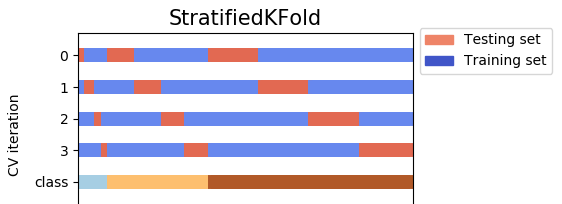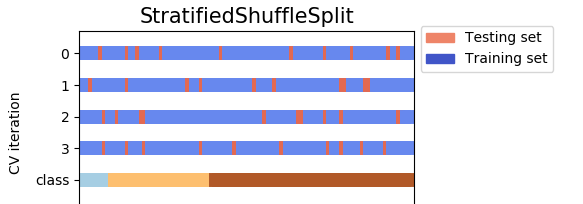Output examples of KFold, StratifiedKFold, StratifiedShuffleSplit:
![Output examples of KFold, StratifiedKFold, StratifiedShuffleSplit]()
The above pictorial output is an extension of @Ken Syme's code:
from sklearn.model_selection import KFold, StratifiedKFold, StratifiedShuffleSplit
SEED = 43
SPLIT = 3
X_train = [0,1,2,3,4,5,6,7,8]
y_train = [0,0,0,0,0,0,1,1,1] # note 6,7,8 are labelled class '1'
print("KFold, shuffle=False (default)")
kf = KFold(n_splits=SPLIT, random_state=SEED)
for train_index, test_index in kf.split(X_train, y_train):
print("TRAIN:", train_index, "TEST:", test_index)
print("KFold, shuffle=True")
kf = KFold(n_splits=SPLIT, shuffle=True, random_state=SEED)
for train_index, test_index in kf.split(X_train, y_train):
print("TRAIN:", train_index, "TEST:", test_index)
print("\nStratifiedKFold, shuffle=False (default)")
skf = StratifiedKFold(n_splits=SPLIT, random_state=SEED)
for train_index, test_index in skf.split(X_train, y_train):
print("TRAIN:", train_index, "TEST:", test_index)
print("StratifiedKFold, shuffle=True")
skf = StratifiedKFold(n_splits=SPLIT, shuffle=True, random_state=SEED)
for train_index, test_index in skf.split(X_train, y_train):
print("TRAIN:", train_index, "TEST:", test_index)
print("\nStratifiedShuffleSplit")
sss = StratifiedShuffleSplit(n_splits=SPLIT, random_state=SEED, test_size=3)
for train_index, test_index in sss.split(X_train, y_train):
print("TRAIN:", train_index, "TEST:", test_index)
print("\nStratifiedShuffleSplit (can customise test_size)")
sss = StratifiedShuffleSplit(n_splits=SPLIT, random_state=SEED, test_size=2)
for train_index, test_index in sss.split(X_train, y_train):
print("TRAIN:", train_index, "TEST:", test_index)




StratifiedKFoldsamples without replacement whileStratifiedShiffleSplitshuffles with. So, one advantage ofStratifiedShiffleSplitis you can sample as many times as you want. Sure, individual samples will have overlap -- so any fitted models on the samples will be correlated -- but you can fit many more models, and with more data per model. – CackaStratifiedKFoldis the true cross-validation. However,StratifiedShiffleSplitis a "generator", and it randomly generate different "train-test" splits forn_splitstimes. – Intensify